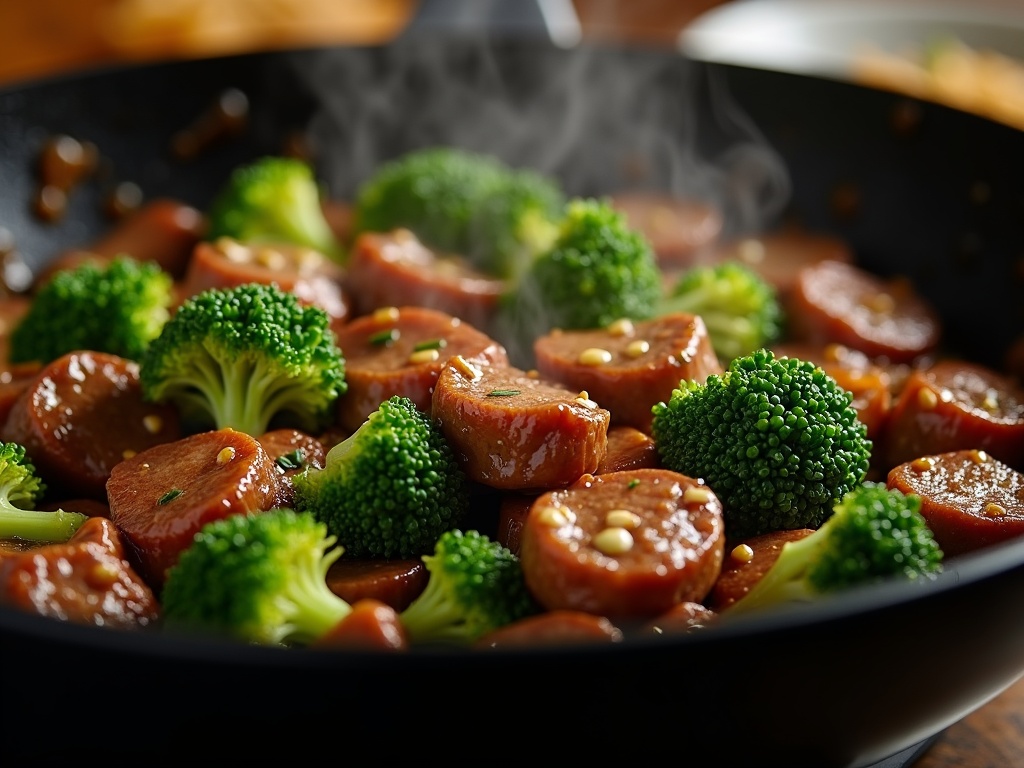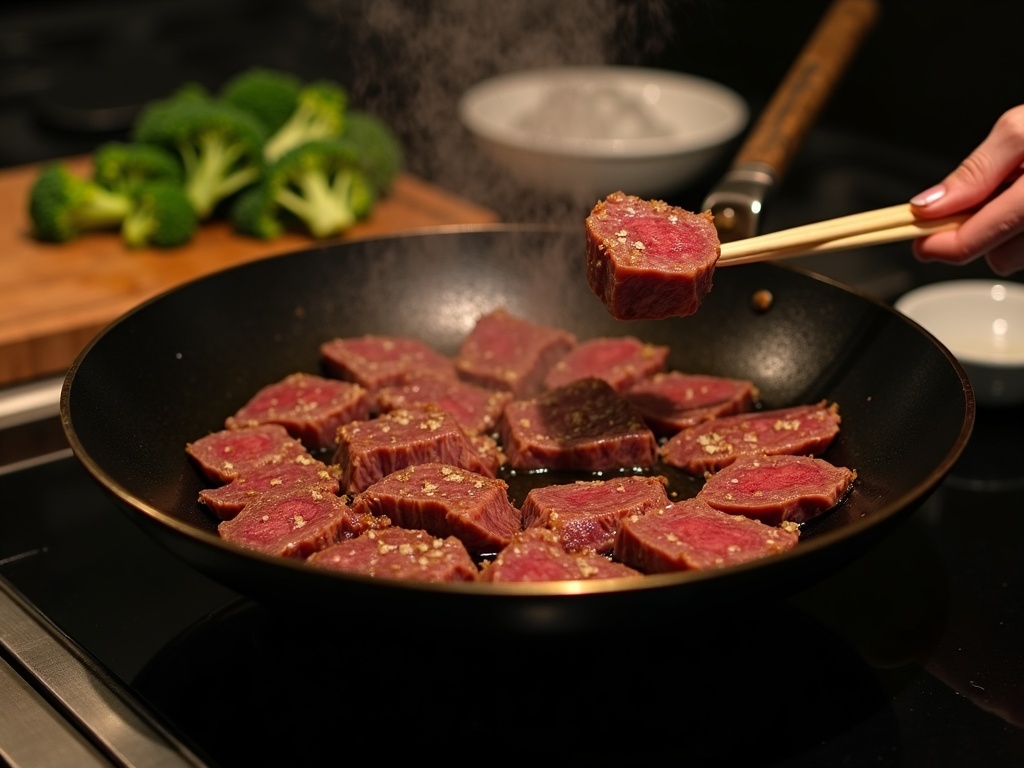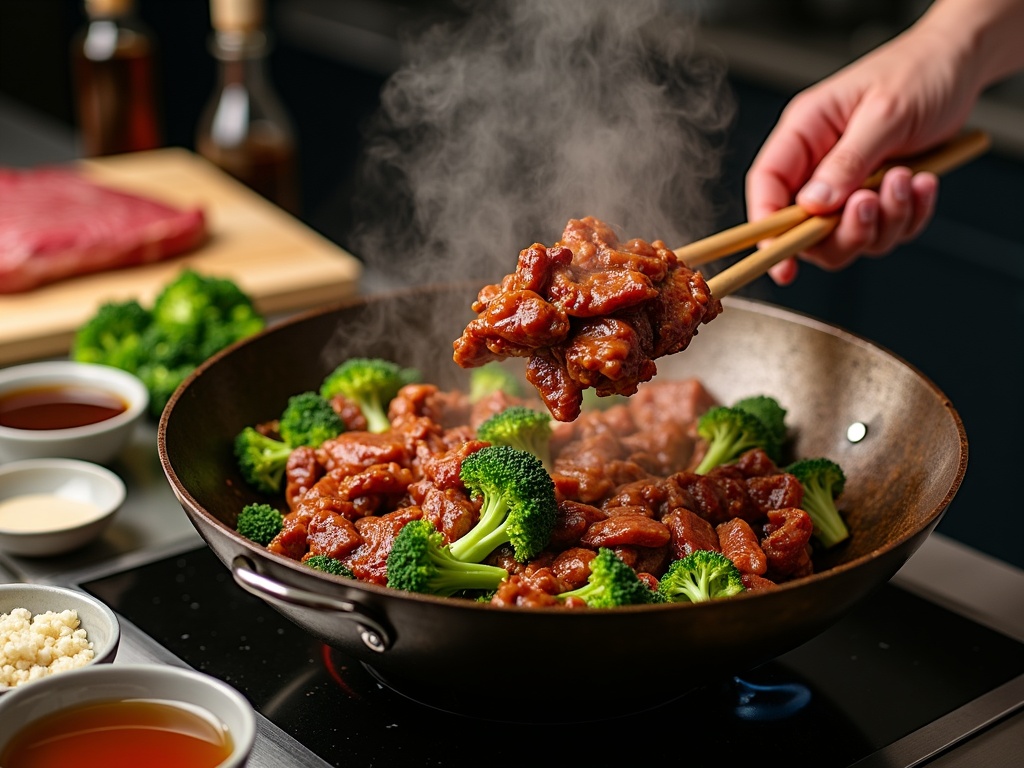Classic Beef and Broccoli: Mastering the Takeout Favorite
Classic beef broccoli combines tender, thinly sliced beef with vibrant, crisp broccoli in a richly savory sauce made from soy sauce, oyster sauce, and fresh aromatics.
Find In This Article
Key Takeaways
- Fresh ingredients are essential, particularly high-quality beef (such as flank steak or sirloin), fresh broccoli florets, and a combination of soy sauce and oyster sauce for authentic flavor.
- Proper beef preparation techniques include slicing thinly against the grain, marinating with cornstarch (also known as velveting), and cooking quickly at high heat to ensure tender meat.
- Cooking components separately and in the correct sequence prevents overcrowding—sear the beef first, remove it, then cook broccoli before combining everything with sauce.
- The signature sauce requires a balanced combination of soy sauce, oyster sauce, fresh garlic, ginger, beef broth, and a touch of sesame oil added at the end.
- Avoid common mistakes like overcrowding the pan, using cold meat, or cooking broccoli too long, which can result in tough beef and mushy vegetables.
For a deeper look into techniques such as velveting and tips for maximizing wok cooking efficiency, check out this guide on The Woks of Life, a trusted resource for home-style Chinese cuisine.
What You’ll Need For Restaurant-Style Results
Creating authentic beef and broccoli at home doesn’t require a professional kitchen—just the right ingredients and techniques. I’ve spent years perfecting this classic dish, and the secret lies in using high-quality components that bring out those distinctive flavors you’d expect from your favorite Chinese restaurant.
Essential Ingredients for Perfect Beef Broccoli
The foundation of any great beef broccoli dish starts with the right cut of meat. Flank steak offers excellent flavor with its rich, beefy taste, while sirloin provides tenderness that’s hard to beat. Whichever you choose, slice it against the grain into thin strips—this crucial step ensures your beef stays tender rather than chewy.
Fresh broccoli florets are non-negotiable. While frozen broccoli might seem convenient, fresh florets retain their bright green color and satisfying crunch that contrasts beautifully with the tender beef.
For the sauce, you’ll need several key components:
- Soy sauce provides that distinctive umami base
- Oyster sauce adds depth and richness that’s impossible to replicate
- Fresh garlic and ginger create aromatic complexity
- Cornstarch acts as the thickening agent for that glossy restaurant-style sauce
- A splash of sesame oil brings nutty aroma that elevates the entire dish
- Brown sugar balances the saltiness with subtle sweetness
- Beef broth expands the flavor profile while providing enough liquid for the sauce
Many home cooks miss the importance of cornstarch in this recipe. Beyond thickening, it’s essential for creating that tender texture in the beef through a process called velveting. I often coat my beef slices lightly in cornstarch before cooking, which protects the meat from high heat and creates that melt-in-your-mouth quality found in restaurant versions.
The combination of soy and oyster sauces creates that distinctive flavor profile that’s immediately recognizable as beef broccoli. Don’t substitute one for the other—they work in tandem to produce the perfect savory balance.
Fresh aromatics make a significant difference too. Pre-minced garlic and powdered ginger simply don’t compare to freshly minced cloves and grated root. The vibrant, sharp flavors they provide cut through the richness of the beef and sauce.
Sesame oil should be added at the end of cooking rather than used as a cooking medium. Its flavor compounds are delicate and can be destroyed by high heat. Just a teaspoon brings remarkable complexity to your finished dish.
If you’re looking to expand your Chinese cooking repertoire, beef chow mein uses many of these same ingredients, making it a natural next step. Similarly, Mongolian beef noodles share this ingredient foundation but introduce different textures and flavor balances.
The quality of your beef broth matters tremendously. Low-sodium varieties allow better control over the saltiness, especially since soy and oyster sauces already bring considerable salt to the dish. I prefer making a quick homemade broth when possible, but a good-quality store-bought version works well too.
With these ingredients ready, you’re set to create a beef broccoli dish that rivals your favorite takeout spot. The combination of tender beef, crisp broccoli, and that glossy, flavorful sauce creates a harmonious balance that’s both satisfying and authentic.
Getting That Melt-In-Your-Mouth Beef
The secret to perfect beef and broccoli isn’t just about the sauce—it’s about achieving that tender, succulent texture that dissolves on your tongue with each bite. I’ve mastered a few techniques that transform even tougher cuts into wonderfully tender morsels that’ll make your homemade version rival any restaurant’s.
Critical Preparation Steps
The journey to perfectly tender beef starts before it even hits the wok. First, I always slice my beef against the grain. This means cutting perpendicular to the visible muscle fibers, which shortens them and makes each bite easier to chew. For beef broccoli, I prefer thin slices about ⅛-inch thick—the thinner the slice, the more tender the result. A partially frozen piece of beef (about 30 minutes in the freezer) makes this precision cutting much easier.
After slicing, marinating is non-negotiable. I let my beef rest for at least 30 minutes in a mixture that typically includes soy sauce, a touch of oil, and sometimes a splash of rice wine. This not only infuses flavor but begins the tenderizing process at a molecular level. The salt in soy sauce helps break down muscle proteins, resulting in a more tender final product. For extra flavor depth, try adding minced garlic or ginger to your marinade—these aromatics nicely complement both beef chow mein and classic beef broccoli dishes.
The magic tenderizing technique that sets restaurant-quality beef broccoli apart is velveting. This traditional Chinese cooking method uses cornstarch to create a protective coating that shields the beef during cooking. I mix 1-2 teaspoons of cornstarch into my marinade, ensuring each slice is evenly coated. This starch barrier prevents the proteins from tightening too much during cooking, keeping the meat juicy and tender.
For the actual cooking, timing and temperature are everything. I heat my wok or large skillet until it’s smoking hot before adding a high-heat oil like peanut or grapeseed. The beef goes in small batches—overcrowding causes steaming instead of searing—and I stir-fry it quickly for just 1-2 minutes. Cooking too long will toughen even the most carefully prepared beef. Once the pieces have just lost their pink color, I immediately remove them from the heat.
This quick-cooking approach works brilliantly for various cuts. While flank steak is my go-to for beef broccoli, these same techniques work wonderfully for Mongolian beef noodles or other stir-fries. For more economical options, you could even adapt these methods for ground beef recipes by learning how to cook ground beef properly before incorporating it into Asian-inspired dishes.
The beauty of mastering these techniques is that they’re transferable to countless dishes. Once you’ve nailed the art of perfectly tender beef, you’ll find yourself applying these principles to all your stir-fries—creating restaurant-quality meals that feature that coveted melt-in-your-mouth texture every single time.
Remember that the quality of your starting ingredients matters too. While these techniques can improve any cut of beef, starting with a naturally tender cut like sirloin or ribeye gives you an advantage. However, with proper slicing, marinating, velveting, and quick cooking, even more affordable cuts like flank or skirt steak can yield impressively tender results in your beef broccoli.
Bringing It All Together
The final assembly of beef and broccoli requires careful timing to ensure each component maintains its perfect texture. I’ve found that following a specific sequence creates that restaurant-quality finish every time.
Prepping and Cooking Components
First, I blanch the broccoli in boiling water for just 30–45 seconds until it turns bright green. This quick cooking method preserves its crunch while removing the raw taste. Immediately after blanching, I transfer the florets to an ice bath, stopping the cooking process and locking in that vibrant color.
Next, I heat my wok until it’s smoking hot before adding oil. This high heat is crucial for proper stir-frying. The thinly sliced beef goes in next, and I spread it in a single layer, allowing it to sear properly without overcrowding. I cook it just until the outside browns but the inside remains slightly pink—about 1–2 minutes depending on thickness. The beef continues cooking later, so removing it slightly underdone prevents toughness.
Creating the Signature Sauce and Final Assembly
The sauce is what ties everything together. In the same wok, I add:
- Minced garlic and ginger for an aromatic base
- Soy sauce for umami depth
- Oyster sauce for richness
- A touch of brown sugar to balance flavors
- Beef broth for body
- Cornstarch slurry to thicken
After letting these ingredients simmer for about 30 seconds to release their flavors, I return the beef to the wok, followed by the blanched broccoli. I toss everything together with a quick flipping motion to coat each piece evenly without breaking the broccoli florets.
The final step involves simmering the mixture for just 1–2 minutes until the sauce thickens to a glossy consistency that clings to both the beef and broccoli. This brief cooking time allows the flavors to meld while preserving the tender-crisp texture of the broccoli and preventing the beef from becoming chewy.
For an extra dimension of flavor, I sometimes add noodles to transform this into a hearty one-dish meal similar to beef chow mein. The key is maintaining that perfect balance where the beef is tender, the broccoli bright and crisp, and the sauce rich and clingy without being too thick.

Common Mistakes To Avoid
Cooking beef with broccoli in a stir-fry seems straightforward, but several pitfalls can turn this delicious dish into a disappointing dinner. I’ve learned these lessons through plenty of trial and error, and now I can help you skip the learning curve.
Temperature and Space Issues
Overcrowding the pan is perhaps the most common mistake I see home cooks make. When too much beef is added at once, the meat ends up steaming rather than searing. This results in gray, rubbery meat instead of that beautiful caramelized exterior we’re aiming for. I cook beef in small batches, leaving plenty of space around each piece to allow proper browning.
Using cold meat straight from the refrigerator is another major error. Cold beef hits a hot wok and immediately lowers its temperature, preventing proper searing. I always let my beef sit out for about 20–30 minutes before cooking to take the chill off.
Not letting the wok get hot enough before adding ingredients is a critical mistake. A properly heated wok creates that signature “wok hei” flavor through quick caramelization. I heat my wok until it’s smoking slightly before adding oil, then swirl the oil to coat the surface before adding my beef.
Vegetable Timing
Overcooking the broccoli transforms what should be vibrant, slightly crisp florets into a mushy, dull green mess. This not only ruins the texture but also diminishes the nutritional value of your dish. To achieve perfect broccoli:
- Add broccoli after the beef has been cooked and removed from the pan
- Keep florets uniform in size for even cooking
- Consider blanching larger broccoli pieces beforehand
- Cook just until the broccoli turns bright green
- Remember it will continue cooking slightly from residual heat
When I first started cooking Asian beef dishes, I often added everything to the wok at once. Now I know that proper stir-frying is about timing and temperature control. I always have all ingredients prepped and ready before heating my wok, allowing me to add each component at precisely the right moment.
The final texture of your beef is largely determined by how you slice it. I always cut beef against the grain in thin, even slices to ensure tenderness, a step many home cooks overlook.
By avoiding these common mistakes, you’ll elevate your beef and broccoli from merely acceptable to restaurant quality, impressing family and friends with your stir-fry skills.

Pro Tips For Better Beef Broccoli
Perfecting beef and broccoli stir-fry at home requires attention to detail and a few chef tricks. I’ve learned these techniques through years of trial and error, and they’ve transformed my homemade version from good to restaurant quality. These simple adjustments make all the difference in texture, flavor development, and overall results.
Preparation Techniques That Make a Difference
Cutting your beef and broccoli pieces uniformly is crucial for even cooking. When pieces vary in size, smaller bits overcook while larger pieces remain undercooked. I aim for beef slices about 1/4 inch thick and broccoli florets roughly the same size. This simple step ensures everything finishes cooking at the same time.
Before cooking, I always pat the beef dry with paper towels. This might seem minor, but it’s a game-changer. Moisture on the meat surface creates steam when it hits the pan, preventing proper searing and caramelization. Dry beef develops that beautiful brown crust that adds depth of flavor to your dish.
Temperature matters significantly when cooking beef. I take my meat out of the refrigerator about 20-30 minutes before cooking. Room temperature beef cooks more evenly and develops better browning than cold meat straight from the fridge. This small waiting period yields much better results.
The cooking vessel and heat level can make or break your beef stir-fry dishes. I use a very hot wok or large skillet to achieve that authentic restaurant-style sear. Preheating your pan until it’s almost smoking creates the perfect environment for quick cooking and flavor development without steaming the ingredients.
Preparation and organization before cooking are non-negotiable for stir-fry success. Here’s what I prepare before turning on the heat:
- Meat sliced and patted dry
- Broccoli cut into even florets
- Sauce ingredients mixed in a separate bowl
- Garlic and ginger minced and ready
- Cornstarch slurry prepared if thickening is needed
- Serving plate or bowl nearby
This mise en place (everything in place) approach is essential because once cooking begins, the process moves quickly. Stir-frying typically takes just minutes, so scrambling for ingredients mid-cook can lead to overcooking and subpar results.
For the most tender beef texture, consider velveting your meat—a Chinese restaurant technique. I marinate the beef slices briefly in a mixture of cornstarch, egg white, and rice wine before cooking. This creates a protective coating that keeps moisture locked inside the meat during the high-heat cooking process.
Cooking in batches is another professional tip I swear by. Overcrowding the pan lowers its temperature and causes steaming instead of searing. I cook beef in small batches, removing each batch before adding the next, then return everything to the pan at the end to combine with the sauce.
For beef dishes that call for ground meat instead of sliced, the same principles apply. Properly cooking ground beef requires similar attention to temperature and moisture control.
The right sequence also matters—I typically sear the beef first, remove it from the pan, then cook the broccoli before combining everything with sauce. This prevents the beef from overcooking while the broccoli gets tender.
These techniques might seem like extra steps, but they don’t add significant time to your cooking process. Instead, they enhance the quality of your beef broccoli and bring restaurant-worthy results to your home kitchen.
Make-Ahead and Storage Tips
I’ve found that beef and broccoli is one of those meals that works beautifully for meal prep and makes excellent leftovers. A little strategic planning can save you significant time during busy weeknights.
Prepping Components in Advance
Preparing ingredients ahead of time can cut your actual cooking time in half:
- Slice beef thinly against the grain and store in an airtight container for up to 24 hours
- Cut broccoli into florets, wash thoroughly, and dry completely before storing (moisture is the enemy of freshness)
- Pre-mix your sauce and refrigerate in a sealed jar for up to 3 days
- Mince garlic and ginger in advance and store in small containers
This approach is particularly helpful when planning to make beef chow mein or similar stir-fry dishes that share similar ingredients.
When storing leftovers, transfer completely cooled beef and broccoli to airtight containers. They’ll keep fresh in the refrigerator for up to 3 days. For best quality, I recommend storing the rice separately from the beef and broccoli mixture.
To reheat properly, add a splash of water or beef broth to prevent drying out. The microwave works in a pinch (1-2 minutes, stirring halfway), but for best results, quickly reheat in a hot skillet or wok. This maintains the texture of both the beef and broccoli better than microwave reheating.
Freezing is an option if you’ve made a large batch of Mongolian beef noodles or other beef dishes. Store in freezer-safe containers for up to 2 months. The one caveat: broccoli tends to become softer after freezing and thawing, so expect a texture change.
For those who regularly cook with ground meat, these storage principles apply similarly to ground beef recipes as well. Just make sure you’ve thoroughly cooled any cooked beef before refrigerating or freezing.
I’ve found that the key to successfully cooking ground beef or beef strips for meal prep is to slightly undercook it if you plan to reheat later. This prevents the meat from becoming tough when you warm it up for serving.

